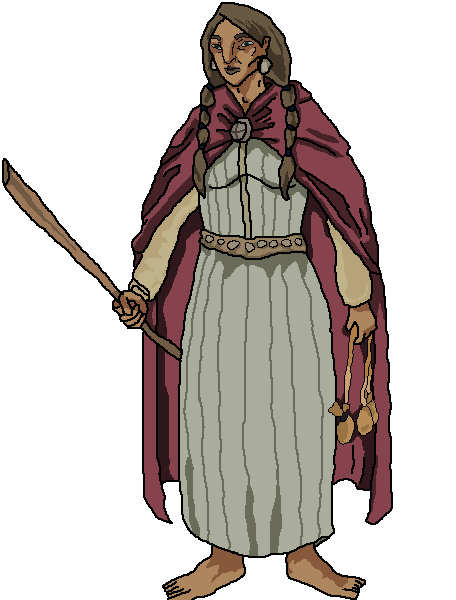Arawarenses
The mix of the Arawayan nomads from the tropical north and the steppe-dwelling Wunarenses first appeared with the foundation of Nuobaroma, and it expanded all through the Tubichá river. These dusky-skinned, stocky people are known for being both very religious and great smiths, putting as much effort in their metalwork as they do in their missionary work, both peaceful and warlike.
Naming Traditions
Feminine names
Marí, Álva, Iuana, Viktoria, Wilma, Ana, Kekilia, Milakro, Pas, Suyaí, Jandra, Gímena, Aylén
Masculine names
Niko, Jandro, Lujka, Marko, Murisco, Mítero, Atrizzio, Gímeno, Iuan, Uíktor, Sekilio, Seqiel
Family names
Yaguatí, Bérez, Cholz, Rámrez, Kristukruz, Ytsenc, Agmembuy
Culture
Major language groups and dialects
Shared customary codes and values
The Arawarenses are a very religious folk, seeing as how they can trace their people's existance back to the foundation of a monastic colony, and how the biggest factor on their people's expansion is missionary work and holy war. As such, religion and to a lesser degree superstition take a very large role on Arawarense society. Family values, influenced by Catholicism, are very conservative, seeing the father as the most important figure when it comes to social influence, but being an equal or subordinate to the mother within the household. For this reason the word for mother and the word for a female boss or chieftain (Ge-pha) are the same in their language.
Large families are encouraged, and finding couples with six or more children is not uncommon.
Foreigners are not regarded with suspicion, as their missionary tradition necessitates them being relatively open to foreign cultures. However, that openness does not apply to foreign religions. The Arawarenses refer to practicioners of other religions, particularily heathen religious leaders, as "kurepa", literally "pigs".
Average technological level
Early-middle iron age
Common Dress code
Being from the steppes and shrublands from around the Tubichá river, the Arawarenses suffer both hot summers and cold winters. As such, their dress tends to be similar to that of their less civilized Wunarense cousins, though swapping the furs for cloth when practical. Cloaks and ponchos are common sights in winter, held together by wood, bronze, iron, gold or silver pins, the materials they are made with signal their social status, and the emblem emblazoned on it, their clan allegiance. In summer, sleeves shorten and footwear changes from leather footwear to simple sandals. Men tend to go barechested or with a cloth band wrapped around one of their shoulders.
Common Taboos
Exploration and settling of ruins once taken by the Fog is frowned upon if not outright forbidden, as is any sort of dealing with Duendes, though some more rural communities might overlook that when survival is necessitated. Any non-hostile behaviour towards unnatural beings and object in general is seen with suspicion, including unnatural artifacts and locations. Machis, Brujos and other magically-inclined people tend to be inducted into the priesthood/nunnery, where they can use their abilities for communicating with the nature spirits in a way permissible by the Faith.
Common Myths and Legends
The Arawareneses share several myths and legends with their cousins the Arawayos and the Wunarenses. Chief amongst them the Arawayan legend of a war before the Fog that ended up with hordes of Kurepas killing almost all of their men, leaving the women in charge of their old kingdom for years.
There is also the Wunarense belief in the Bad Light, a malicious spirits and animals that stalks travellers at night, luring them into a death in the darkness. Unfortunately, since the Fog, that legend told by peasants around campfires turned out to be painfully true.
Historical figures
Pope Jandro I of Nobaruma
Ideals
Gender Ideals
Though patriarcal, a degree of the relatively more egalitarian Arawayan society remained in this new, mixed ethnicity. Women are seen as capable of doing many jobs other societies see as male-centric such as smithing, sailing or construction. However, men are still seen as inherently dominant in the public space. That is not so true on the private space, where the husband is seen as an equal, if not a subordinate, of the wife. Although after marriage the wife will be considered part of the husband's family and go to live among his clan when possible, she will still keep her own family name.
In Kastiwasho, the Arawarense language, just as in the Arawayan language, the words for mother and female boss/chieftain, are the same; Ge-pha.
Parent ethnicities
Encompassed species
Related Organizations
Related Items
Related Locations
Remove these ads. Join the Worldbuilders Guild










Comments